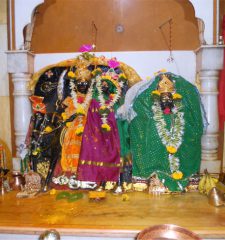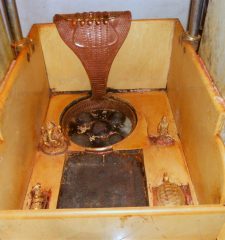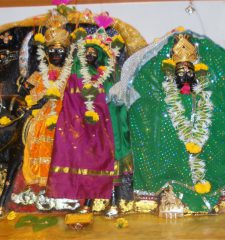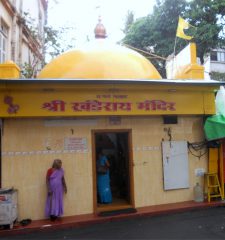The Holy Temple of Lord Khandoba in Walkeshwar- Mumbai
In Walkeshwar, Mumbai stands a 250 years old Khandoba temple. Lord Khandoba’s idol depicts him seated on a horse with his wife Mhalsa behind him. His other principal wife Banai is also there at the side. At the bottom of this holy idol are five naturally formed Siva Lingams. These are Swayambhu Lingams. Swayambhu Lingams are “self-manifested” or “that which is created by its own accord”.
Lord Khandoba is a regional Hindu deity, worshipped by all communities and castes and he treats all communities irrespective of caste equally. The same is with Lord Siva, please read the section on Caste in my book Sayings of Lord Siva, which is available free in this website.
Lord Khandoba also known as Lord Martanda Bhairava and Lord Malhari, The powerful protective deity is a Hindu god, worshipped as a form of Shiva, mainly in the Deccan plateau of India, especially in the states of Maharashtra and Karnataka.Lord Khandoba is worshipped by all communities and castes.
He is depicted either in the form of a Lingam, or as an image of a warrior riding on a bull or a horse. The foremost centre of Lord Khandoba worship is Jejuri in Maharashtra. The legends of Khandoba, found in the text MalhariMahatmya and also narrated in folk songs, revolve around his victory over demons Mani-Malla and his marriages.
Lord Siva took the avatar of Lord Khandoba to ease the suffering of his devotees and bring success to his devotees.
There existed two powerful and merciless giant brothers, named Mani and Malla used to find pleasure in destroying temples and killing the innocents.
Lord Khandoba fought bravely and defeated Mani-Malha; he later got entitled as “Malhari-Martand. He invented a new weapon called “Khanda”, so he was also popularly known as “Khandoba” “Khande Raya” or “KhadeRao” i.e. Lord with weapon named Khanda. Lord Khandogba is believed as very strict, well-disciplined deity, still holds court at the fort of Jejury.
In idols Khandoba or Maillara or Maillanna is depicted as very tall, strong-stout, having four arms, each carrying a damroo(drum),Trishul(trident), Paan-patra (Bowl filled with paan or opum leaves) and khanda (sword). This deity is often either dressed as Maratha Sardaar with Shinde-shahiPagadi (Pagadi or Turban draped in Scindia’s style) or wearing Pathan Suit i.e. Punjabi styled pajama, long shirt, jacket and an orange colored or pink colored or striped Pheta (turban), often accompanied by his wife and his pets i.e. a horse and shepherd’s dog.He is depicted either in the form of a Lingam, or as an image riding on a bull or a horse.
Lord Khandoba’s principal wives Mhalsa and Banai are also identified with Shiva’s classical Hindu wives Parvati and Ganga.
It is said that Lord Khandobahas got 5 wives from 5 different communities; Mahalasa, Banoo, Rambha, Phoolai and Chandra.Chandra or Chandrai was a Muslim girl who used to trade in oil. One of the most widely worshipped gods of the Deccan plateau, Lord Khandoba is considered as “the premier god of Sakama bhakti (wish-granting devotion) and one of the most powerful deities responsive to vows (navas), navas is a vow to perform service to the God in return for a boon.
Lord Khandoba most auspicious days arejust after KarthikAmavasya, i.e. from MargshirshShudhhaPratipada or from 1’st day of Margshirsha, (Month of Dec) Shad-Ratri-utsava or Champa-Shashthi or six days festival of Lord Khandoba starts.During these days, while performing the rituals, yellow colour clothes or the clothes smeared with turmeric powder are worn. The devotees read holy books such as “Martanda-Vijaya” or “Malhari-Mahatmya”. They either fast or have only one meal in a day or eat less food.
SomavatiAmavasya (any Monday, which is a new moon day) or ChaitiPoornima (full moon day of Chaitra or April) are also celebratedas Lord Khandoba’s holy days.Sunday is Lord Khandoba’sfavourite day.
Lord Khandoba’s favourite colour is yellow .Lord Khandoba’s favourite flowered flower is Marigold.
Khandoba is believed to be a kadak (fierce) deity, who causes troubles if not propitiated properly as per the family duties.[ Khandoba is worshipped with Turmeric (Bhandār), Bel fruit-leaves, onions and other vegetables. The deity is offered puranpoli – a sweet or a simpler dish called bharitrodga of onion and brinjal. Mostly a vegetarian naivedya (offering of food) is offered to Khandoba in the temples.
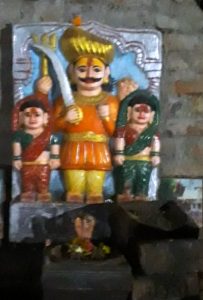
Mangasuli is a village located in Northern Karnataka, India. Mangasuli is known for its temple of Fort Khandoba, among the regions of Southern Maharashtra and Northern Karnataka. The name Mangasuli stands for “Malla” (name of the demon) – “suli” (killed). It is said that Fort Khandoba killed the demon Malla in this place. The other name of Fort Khandoba, Malhari or Mallari, also originates from the words “Malla” and “ari” (enemy) & “Mallayya” in Kannada language. The Khandoba temple is situated inside.
The Bhadra Maruti Temple, Khultabad which is a temple dedicated to the Hindu deity Hanuman, located at Khuldabad, near Aurangabad, Maharashtra.

